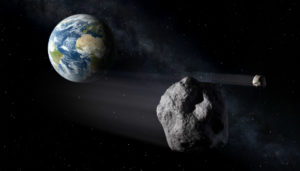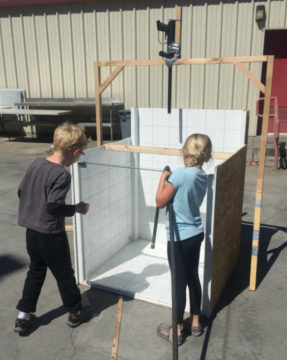Coastal waves from mid-sized asteroid impacts might be more like a storm surge than a wall of watery destruction, according to NASA experiments with paintballs.

NASA
When an asteroid hits the ocean, it's more likely to produce storm-surge-sized waves than giant walls of watery death. That's the preliminary result of an experiment that used paintballs to help clear up some of the confusion around what happens when a space rock splashes into the ocean.
Asteroids come in all sizes, from small 100-meter-wide airbursters to the 10-kilometer giant that decimated the dinosaurs. To understand the ensuing tsunamis from impacts, researchers focused on the mid-range objects, asteroids between about 100 to 1000 meters across.
"They are big enough to hit the ocean but small enough they won't cause a global climate disaster — in which case the tsunami may be a minor risk, not the major one," says Darrel Robertson (NASA Ames Research Center). Robertson and his colleagues presented their paintball experiment in October at the annual American Astronomical Society's Division for Planetary Sciences conference in Knoxville, Tenn. Their preliminary results suggest that waves from mid-sized asteroids will be less dangerous than predicted by some previous models, though Robertson emphasized that the subject is part of an ongoing discussion in the planetary defense community.
"For coastal communities, at the moment we think these impact tsunami waves would not be much more hazardous than storm surges if the impact happens far off shore in the deep ocean," Robertson says. "This restricts the danger zones to impacts on the continental shelves, which is a much smaller region than the entire ocean."
"The answer . . . was paintballs."
Right now, roughly 100,000 asteroids wider than 100 meters come near our planet. These mid-sized objects fall to Earth about once every thousand years and, because water covers nearly three-quarters of the planet's surface, are most likely to impact an ocean.
Computer simulations can help to understand what happens when a medium-sized asteroid hits the ocean. However, recent models fail to match up with Holsapple's law, an equation derived in 1993 from laboratory experiments on asteroid impacts. The law predicted big, dangerous tsunami waves driven by about 15% of the asteroid's kinetic energy, while simulations predicted smaller waves with far less energy. To rectify the two, Robertson and his colleagues decided they needed an entirely new experiment.

D. Robertson (NASA Ames)
Ranging from dozens to hundreds of kilometers long, earthquake-generated tsunamis grow taller when they hit the shore, a deadly rush of water that just keeps coming. But previous simulations suggested that tsunamis generated by impacts are much smaller, with multiple peaks and troughs that can multiply as they move through the deep water. "What you would see on shore is a succession of short-wavelength tsunami waves arriving, first growing bigger in height and then smaller," Robertson said.
Simulating the asteroid required a small object moving at around 10 kilometers per second, and Robertson says that a bullet was one of the first things the team considered. However, a bullet's structural strength means it holds it shape when fired into water, whereas asteroids vaporize. Craters shapes also differed.
"What I needed was something about the size and speed of a bullet that went splat when it hit the water," Robertson says. "The answer to that was paintballs."
The researchers fired a modified paintball gun into a plywood-and-acrylic tank about 3 feet (1 meter) deep. As NASA-sanctioned research, the project also required oversight by the Sanford Police Department for safety reasons. With ammunition donated from Cutting Edge Paintballs of San Jose, the paintball gun that they already owned, and a borrowed high-speed camera, the total cost for the experiments was around $200.
"Honestly, the logistics of getting hold of a paintball gun, a high-speed camera, and getting official approval to do it was the challenging part," Robertson says. "The rest was lot of fun."
Making waves
Everything looked good, but when the researchers pulled the trigger, the first shots didn't splat instantly on impact. Only after one of the paintballs split inside the gun barrel and made a significantly larger crater than its predecessors did they realize that the strength of the paintball shell was a problem. They tried to soften the shells by heating them in a microwave or soaking them in water, but it didn't make a difference.
Finally, they decided to fire the paintballs across an exposed razor to split the shell before hitting the tank. Robinson said it was "exactly what we were looking for." They fired shots into the water at different depths, and the high-speed camera tracked the results.
(Article continues after video.)
If an asteroid splashes down in deep water, the preliminary results suggest that the resulting waves would resemble a storm surge, creating floods but avoiding a dangerously looming wall of water. The researchers also collected information about the size of the crater formed when an asteroid crashes into shallow water. If the waves break when they reach the continental shelf instead of at the beach, they may be more hazardous to shipping lanes than to the people on the shore, Robertson says.
For now, the team is working to fit the equations to the experimental results. They plan to investigate how energy moves between the craters and the tsunami waves, a turbulent process. According to Robertson, the energy lost during this transition is not well understood and can vary depending on the properties of the impact, such as the density, size, and impact angle of the incoming object.
"Since we can reproduce the paintball experiments in simulations quite accurately, it gives us more confidence that our asteroid simulations are correct, and that the tsunami hazard is significantly smaller than has been previously predicted by some models," Robertson says.
Robertson says the experiment can be replicated by college and even high school students, though he emphasized the need to be safe. He said valuable data can be gathered with an unmodified paintball gun, and that you should never shoot someone with a modified weapon. He also reminded anyone interested to keep the chamber empty and the safety on until the gun is mounted on the stand and aimed at the ground. Water balloons and handfuls of sand could also produce interesting results.
"Most importantly, have fun!" he says.
Editor's Note: This article was updated on November 19th to correct the spelling of one of the researcher's children in the photo caption. Sorry, Ginevra!
 0
0








Comments
You must be logged in to post a comment.